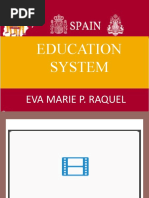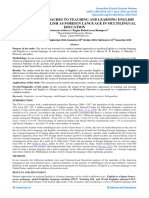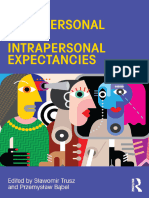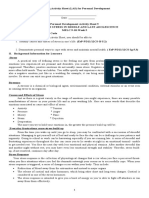Activity 7
Uploaded by
spesher92Activity 7
Uploaded by
spesher92Activity 1. Affixes. Complete the exercise on the table.
Prefi Definitio Example Example
x n
Anti- Against Social antisocial
Non- Not Sense Nonsense
Over- More Rate Overrate
than
Trans- Across Pacific Transpacific
Inter- Through Continent Intercontinen
al tal
Super Beyond Active Super active
-
Semi- part Circle Semicircle
Suffix Definition Example Example
-tion The act of Examine Examinatio
n
-ion The act of Celebrate Celebration
-or One who Translate Translation
does
-ity State of Divine Divinity
being
-ment State of Achieve Achieveme
being nt
-ic Relating to Photogra Photograph
ph ic
-ian One who Music Musician
does
-ist One who Psycholo Psychologi
does gy st
-ous Full of/having Danger Dangerous
-eous Full of/having Mystery Mysterious
-ious Full of/having Glory Glorious
Activity 2. Write ten compound words.
Baseball: Beisbol (base-pelota)
Basketball: Baloncesto (cesta-balón)
Football: Futbol / balonpie (pie-balón)
Dodgeball: Quemados (Esquivar-pelota)
Spiderman: Hombre araña (araña-hombre)
Starfish: Estrella de mar (Estrella-pez)
Brainstorm: Lluvia de ideas (cerebro-tormenta)
Daredevil: Atrevido/temerario(atreverse-diablo)
Outlaw: Prohibir (fuera-ley)
Milestone
Activity 3. In the following texts about EDUCATION IN MEXICO
identify the clue words (blue) and new words (yellow) and
translate
Education in Mexico
The Mexican education system has had its share of struggles. The
dropout rate in public schools in high, and rural schools are underfunded
and have a shortage of buildings, teachers and textbooks. Urban public
schools are better, but the quality of education is still relatively low,
while private schools grant a high quality of bilingual education that is
usually well suited to expat children but can be expensive.
The education system in Mexico is often segregated by social class and
stark differences are seen between more developed northern and
central states compared to southern regions. Wealthy families normally
send their children to public schools.
Many expats homeschool their children or send them to a Mexican
school for half the day and homeschool them in the afternoons.
Immersion in a Mexican school for half the day can help expat children
learn Spanish and assimilate better into the local culture.
Public schools in Mexico
Although public schools in Mexico charge no tuition and textbooks are
freely available in primary schools, they are unlikely to be an expats first
choice for their children due to poor and differing standards.
The Mexican education system is regulated by the Secretariat of Public
Education (SEP) and is administered by individual states. Public schools
in Mexico are secular as religious instruction is banned in public
education, and school days in Mexico are shorter than that of many
other countries. The school year usually runs from September to the
following June.
The system is normally divided into three levels:
Primary school (primaria): grades one to six, ages six to twelfth.
Junior high school (secundaria): grades seven to nine, ages 12 to
15.
High school (preparatoria): grades 10 to 12, ages 15 to 18.
Children must achieve at least 60 percent in the national examination at
the end of each school year to proceed to the next grade.
For high school, students have several options. Students can attend
specific colleges for technological, technical and vocational training
courses and receive a bachillerato, preparing them for the workforce.
Otherwise, students who attend preparatoria gain a general education in
subjects they may specialize in, such as in physical or social sciences.
This prepares them for tertiary education.
Private schools in Mexico
Most expats send their children to private or international schools, which
are concentrated in the big cities, as they offer a broader curriculum and
better teachers than public schools. While public schools are secular,
religious education may be available at some private schools.
When considering a private school, expats should ensure that it is
accredited through the SEP and visit the school, meet with teachers and
check the curriculum to see if it is a suitable option. Parents may not be
able to do this themselves before moving, but relocation companies
offer extensive school-searching services.
Those witch children who will be going to university in their home
country should also ensure that the school is accredited internationally.
Expats enrolling their children in a private school in Mexico will usually
need to present school records proving that their child has completed
the previous year of school and has qualified to continue to the next
grade level. Schools usually ask for a copy of the child’s birth certificate,
a copy of their school records and photo identification for the child and
the parent.
Bilingual schools in Mexico
Bilingual education is available in both public and private schools.
Language is a complex issue affecting education in Mexico and its not
just a challenge for foreign students: around sixty indigenous languages
are spoken in the country.
Often in bilingual schools, half the day is taught in Spanish and the other
half in a second language, usually English, French or one of the main
native languages. International schools cater not only for the language
but also curriculum of one’s home country.
Activity 4. Write your personal point of view of each topic.
Topic 1 (Spanish): La educación en México es realmente aprobatoria y
sugestionada en la obligación de tener un estudio completo, garantizado
y gratuito, pese a todo ello, es muy alto el porcentaje de personas
analfabetas, que no buscan un futuro de si y sus beneficios en el mundo
globalizado.
(English) Education in Mexico is really approving and influenced by the
obligation to have a complete, guaranteed and free study, despite all
this, the percentage of illiterate people is very high, who do not seek a
future of themselves and their benefits in the globalized world.
Topic 2 (Spanish). Escuelas públicas en México, realmente son la base
de la educación hoy en día, son más fuertes, pero las privadas, tienen el
privilegio de ser bilingües, es otro dato que cada vez más se está
regularizando, pues ahora las públicas también tienen de encargado un
segundo idioma, en la medida de lo posible.
(English) Public schools in Mexico, are really the basis of education
today, they are stronger, but private ones, have the privilege of being
bilingual, is another fact that is increasingly being regularized, because
now the public ones also have a second language as their as far as
possible.
Topic 3. (Spanish) Las escuelas privadas, gozan de un alto rendimiento
escolar, puesto que en ellas se rige un solo método de enseñanza, la
cual puede iniciar desde el preescolar hasta la secundaria, en lo que
corresponde la escuela básica. El único inconveniente es que es
altamente costosa y solamente un margen mínimo puede llegar a ella.
(English) Private schools have a high school performance, since they
govern only one teaching method, which can start from pre-school to
secondary school, in the corresponding basic school. The only drawback
is that it is highly expensive and only a minimal margin can reach it.
Topic 4. (Spanish) En el presente es posible contar con escuelas que
interculturalicen la educación con los dialectos e idiomas que nos
rodean, por ejemplo, el indígena y el inglés son parte de nosotros a
través de la historia, por ello, es conveniente coexistir con ellos para
mejorar en un entorno globalizado y social que nos abre las redes
sociales y sus mejores disposiciones.
(English) In the present, it is possible to have schools that
interculturalize education with the dialects and languages that surround
us, for example indigenous and English are part of us through history,
Therefore, it is desirable to coexist with them to improve in a globalized
and social environment that opens us the social networks and their best
provisions.
You might also like
- (Oxford World's Classics) Euripides, James Morwood, Edith Hall - The Trojan Women and Other Plays-Oxford University Press (2009) PDF92% (12)(Oxford World's Classics) Euripides, James Morwood, Edith Hall - The Trojan Women and Other Plays-Oxford University Press (2009) PDF939 pages
- Mexico Educational System Curriculum and Instruction100% (1)Mexico Educational System Curriculum and Instruction46 pages
- The Mexican education system is a highly structured system that is divided into several levelsNo ratings yetThe Mexican education system is a highly structured system that is divided into several levels3 pages
- Juan Carlos Sulvarán Morales 906755 ING105No ratings yetJuan Carlos Sulvarán Morales 906755 ING1052 pages
- The Teacher and The School Curriculum Module 2No ratings yetThe Teacher and The School Curriculum Module 26 pages
- An Overview of Models of Bilingual Education: Anna HurajováNo ratings yetAn Overview of Models of Bilingual Education: Anna Hurajová7 pages
- The Unschooler's Educational Dictionary: A Lighthearted Introduction to the World of Education and Curriculum-Free AlternativesFrom EverandThe Unschooler's Educational Dictionary: A Lighthearted Introduction to the World of Education and Curriculum-Free AlternativesNo ratings yet
- Research Paper Focusing On A Fundamental and Re-Occurring Theme in Bilingual Special EducationNo ratings yetResearch Paper Focusing On A Fundamental and Re-Occurring Theme in Bilingual Special Education9 pages
- Responsive Practice for Dual Language Learners in Early Childhood Education: Theory and Case StudiesFrom EverandResponsive Practice for Dual Language Learners in Early Childhood Education: Theory and Case StudiesNo ratings yet
- The Educated Underclass: Students and the Promise of Social MobilityFrom EverandThe Educated Underclass: Students and the Promise of Social MobilityNo ratings yet
- Perspectives of Bilingual Education in Colombia A Money BusinessNo ratings yetPerspectives of Bilingual Education in Colombia A Money Business3 pages
- Education Malaysia Vs America: Public Schools in MalaysiaNo ratings yetEducation Malaysia Vs America: Public Schools in Malaysia8 pages
- Creating Diversity-Rich Environments for Young ChildrenFrom EverandCreating Diversity-Rich Environments for Young ChildrenNo ratings yet
- Module 4: Becoming A Global Teacher: Educ.9 - The Teaching ProfessionNo ratings yetModule 4: Becoming A Global Teacher: Educ.9 - The Teaching Profession5 pages
- The Salvation of Youth: Apprenticeship and the Myth of the Good SchoolFrom EverandThe Salvation of Youth: Apprenticeship and the Myth of the Good SchoolNo ratings yet
- Development of a multilingual online course with the language support for teaching physics in EnglishNo ratings yetDevelopment of a multilingual online course with the language support for teaching physics in English7 pages
- Innovative Approaches To Teaching and Learning EnglishNo ratings yetInnovative Approaches To Teaching and Learning English4 pages
- English As A Second Language Program in Elementary Schools.No ratings yetEnglish As A Second Language Program in Elementary Schools.15 pages
- The Informal System and Hidden CurriculumNo ratings yetThe Informal System and Hidden Curriculum2 pages
- B2016 Interpersonal and Intrapersonal Expectancies, Trusz ROUTLEDGE100% (1)B2016 Interpersonal and Intrapersonal Expectancies, Trusz ROUTLEDGE203 pages
- Module 2 - Handout 2.0 - Demand Theory, Analysis and EstimationNo ratings yetModule 2 - Handout 2.0 - Demand Theory, Analysis and Estimation4 pages
- Stakeholder Analysis Matrix (3.3.2) (10.1)No ratings yetStakeholder Analysis Matrix (3.3.2) (10.1)1 page
- Solid waste sampling is a critical process to analyze and manage waste effectivelyNo ratings yetSolid waste sampling is a critical process to analyze and manage waste effectively2 pages
- MOCK PAPER 1 Marking Scheme November Exam AASLNo ratings yetMOCK PAPER 1 Marking Scheme November Exam AASL32 pages
- La Danse, A Film by Frederick Wiseman 2009No ratings yetLa Danse, A Film by Frederick Wiseman 20095 pages
- 2024 Stanford cs25 Guest Lecture Jason WeiNo ratings yet2024 Stanford cs25 Guest Lecture Jason Wei20 pages
- Million-Day Gregorian-Julian Calendar - Notes100% (1)Million-Day Gregorian-Julian Calendar - Notes10 pages
- 8130.1 Application For Export Certificate of AirworthinessNo ratings yet8130.1 Application For Export Certificate of Airworthiness2 pages
- (Oxford World's Classics) Euripides, James Morwood, Edith Hall - The Trojan Women and Other Plays-Oxford University Press (2009) PDF(Oxford World's Classics) Euripides, James Morwood, Edith Hall - The Trojan Women and Other Plays-Oxford University Press (2009) PDF
- Mexico Educational System Curriculum and InstructionMexico Educational System Curriculum and Instruction
- The Mexican education system is a highly structured system that is divided into several levelsThe Mexican education system is a highly structured system that is divided into several levels
- An Overview of Models of Bilingual Education: Anna HurajováAn Overview of Models of Bilingual Education: Anna Hurajová
- The Unschooler's Educational Dictionary: A Lighthearted Introduction to the World of Education and Curriculum-Free AlternativesFrom EverandThe Unschooler's Educational Dictionary: A Lighthearted Introduction to the World of Education and Curriculum-Free Alternatives
- Research Paper Focusing On A Fundamental and Re-Occurring Theme in Bilingual Special EducationResearch Paper Focusing On A Fundamental and Re-Occurring Theme in Bilingual Special Education
- Responsive Practice for Dual Language Learners in Early Childhood Education: Theory and Case StudiesFrom EverandResponsive Practice for Dual Language Learners in Early Childhood Education: Theory and Case Studies
- Educational Planning (Idealism Tempered in Reality's Forge)From EverandEducational Planning (Idealism Tempered in Reality's Forge)
- The Educated Underclass: Students and the Promise of Social MobilityFrom EverandThe Educated Underclass: Students and the Promise of Social Mobility
- Perspectives of Bilingual Education in Colombia A Money BusinessPerspectives of Bilingual Education in Colombia A Money Business
- Education Malaysia Vs America: Public Schools in MalaysiaEducation Malaysia Vs America: Public Schools in Malaysia
- Creating Diversity-Rich Environments for Young ChildrenFrom EverandCreating Diversity-Rich Environments for Young Children
- Module 4: Becoming A Global Teacher: Educ.9 - The Teaching ProfessionModule 4: Becoming A Global Teacher: Educ.9 - The Teaching Profession
- The Salvation of Youth: Apprenticeship and the Myth of the Good SchoolFrom EverandThe Salvation of Youth: Apprenticeship and the Myth of the Good School
- Development of a multilingual online course with the language support for teaching physics in EnglishDevelopment of a multilingual online course with the language support for teaching physics in English
- Innovative Approaches To Teaching and Learning EnglishInnovative Approaches To Teaching and Learning English
- English As A Second Language Program in Elementary Schools.English As A Second Language Program in Elementary Schools.
- B2016 Interpersonal and Intrapersonal Expectancies, Trusz ROUTLEDGEB2016 Interpersonal and Intrapersonal Expectancies, Trusz ROUTLEDGE
- Module 2 - Handout 2.0 - Demand Theory, Analysis and EstimationModule 2 - Handout 2.0 - Demand Theory, Analysis and Estimation
- Solid waste sampling is a critical process to analyze and manage waste effectivelySolid waste sampling is a critical process to analyze and manage waste effectively
- 8130.1 Application For Export Certificate of Airworthiness8130.1 Application For Export Certificate of Airworthiness

























































































